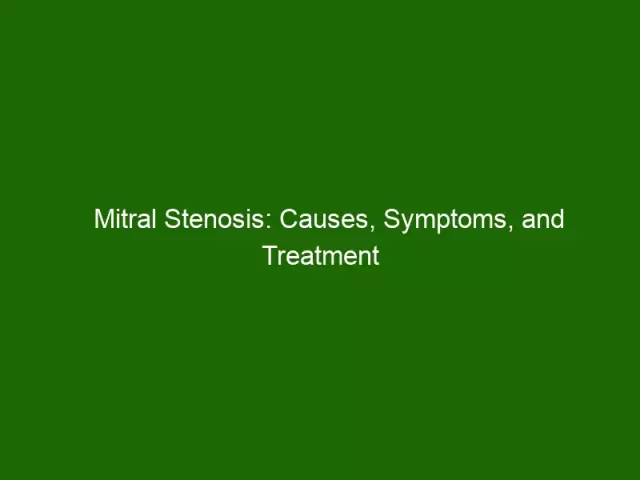- Author Rachel Wainwright [email protected].
- Public 2023-12-15 07:39.
- Last modified 2025-11-02 20:14.
Mitral stenosis

Mitral stenosis or mitral valve stenosis is a significant narrowing of the atrioventricular opening that connects the left atrium and the left ventricle of the heart. At the junction is the mitral valve, which consists of two cusps. With mitral stenosis, the leaflets of the valve thicken, grow together with each other, and reduce the size of the opening.
The area of the left atrioventricular opening in a healthy heart is 4-6 cm 2. Distinct violations in the cardiac circulation appear when the area of the opening decreases to 1.0-1.5 cm 2. When the area is less than 1 cm 2, surgical treatment is indicated.
Mitral stenosis or mitral valve stenosis is classified as an acquired heart disease. It forms more often in women, mainly at a young or middle age. In most cases, mitral valve stenosis is a consequence of rheumatism.
Mitral stenosis: symptoms
For a long time, with a small degree of development, the symptoms of mitral stenosis may not appear at all (latent form). At this stage, mitral valve stenosis is recognized only during clinical and instrumental studies. Even minor stenosis of the mitral valve progresses usually due to the propensity of patients to recurrent rheumatism.
The first symptoms of mitral stenosis appear during its progression, when it is noted:
- Pain in the region of the heart, palpitations with increasing physical activity;
- Shortness of breath during normal exercise or when lying down;
- Increased fatigue;
- Frequent diseases of the upper respiratory tract (bronchitis);
- Swelling of the legs;
- Discomfort in the chest area;
- Characteristic cough with hemoptysis;
- A bluish pink tint to the cheeks and lips (mitral blush);
- Trembling of the chest in the region of the heart.
The standard age for onset of symptoms is 40-50 years, but they occur at an earlier age and in infancy. If you have these symptoms, you should immediately consult a doctor. As a result of a medical examination and examination, the doctor identifies additional or secondary symptoms of mitral stenosis:
- Arrhythmia;
- Heart murmurs;
- Pulmonary hypertension;
- Lung congestion;
- Blood clots.
Mitral stenosis
In 1955, Soviet scientists A. N. Bakulev and E. A. Damir proposed a classification of the degrees of mitral stenosis according to the severity of shortness of breath. This scheme is successfully applied in modern medicine by most specialists.
The degree of narrowing of the atrioventricular opening and hemodynamic disturbance in a small circle are manifested by dyspnea of five stages:
- I - no shortness of breath. Full compensation of blood circulation, no complaints. According to the results of the examination, symptoms characteristic of mitral stenosis are found. The area of the mitral opening is 3-4 cm 2, the left atrium is not more than 4 cm;
- II - there is no dyspnea at rest, it occurs during exercise. Relative circulatory failure, slight increase in venous pressure. The area of the mitral opening is up to 2 cm 2, the left atrium is 4-5 cm;
- III degree of mitral stenosis - constant dyspnea at rest. Severe initial stage of circulatory disorders. Primary phenomena of stagnation of blood in small and large circles. An increase in the size of the heart and liver. Significant increase in venous pressure. The area of the mitral opening is 1-1.5 cm 2, the left atrium is 5 cm or more;
- IV - constant severe shortness of breath. Severe circulatory failure, significant stagnation of blood in a large circle, atrial fibrillation. Significantly enlarged heart, large dense liver. High venous pressure. The area of the mitral opening is less than 1 cm 2, the left atrium is more than 5 cm;
- V - dyspnea of extreme severity, around the clock. Terminal dystrophic circulatory insufficiency. The maximally enlarged size of the heart and liver. Very high venous pressure. Accumulation of fluid in the abdominal cavity, severe peripheral edema. The area of the mitral opening is much less than 1 cm 2, the left atrium is much more than 5 cm.
Mitral stenosis: treatment

The choice of treatment tactics depends on the degree of mitral stenosis:
- At the first stage of asymptomatic mitral stenosis, drugs are not prescribed. It is enough to regularly observe a cardio-rheumatologist and comply with his prescriptions and recommendations;
- At stages II-III, in the presence of minor clinical manifestations, diuretics and beta-blockers are prescribed. Prevention of recurrence of infective endocarditis and rheumatism;
- At stage IV, with a significant increase in the size of the left atrium, a paroxysmal form of atrial fibrillation and thromboembolism, regular administration of indirect anticoagulants is necessary. In this case, the treatment of thromboembolism and atrial fibrillation is carried out according to standard schemes;
- At stages IV-V, with a decrease in the size of the atrioventricular opening to 1.0-1.2 cm 2, recurrent thromboembolism, severe pulmonary hypertension, surgical treatment of mitral stenosis is required.
One of the earliest heart surgeries was operations to treat mitral valve stenosis. Thanks to this, many years of experience have been gained in the surgical treatment of mitral stenosis. The following types of operations have been developed and are being practiced:
- Commissural braking;
- Closed commissural inhibition or balloon valvuloplasty;
- Annuloplasty. Open (often carried out during open commissurotomy) or closed transvenous;
- Prosthetics. Complete replacement of a natural valve with an artificial one (mechanical or biological).
With a disease with mitral stenosis, heavy physical exertion, mental and emotional stress, and strong cooling are contraindicated. With the development of complications, there is a complete disability.
YouTube video related to the article:
The information is generalized and provided for informational purposes only. At the first sign of illness, see your doctor. Self-medication is hazardous to health!






